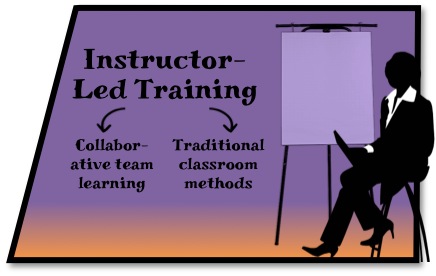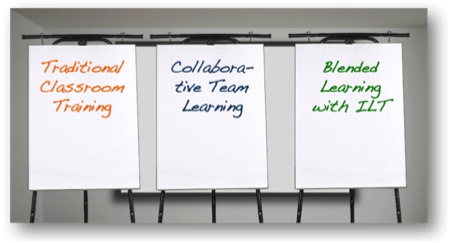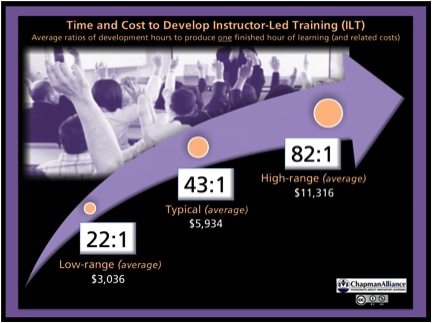What Are the Goals and Costs of
Designing Instructor-Led Training?
by Adele Sommers

Instructor-led training (ILT) has evolved tremendously from the days in which we all trudged dutifully to physical classrooms and enjoyed lecture-dominated (and oftentimes snooze-worthy) learning experiences!
While that might still be the case in many settings, training design has gradually been shifting over the decades to reflect the latest research-based methods that effectively model how people learn best.
While these newer methods have not yet been universally adopted, they represent a trend arising from a realization that training is an expensive, highly ephemeral experience with a rapid “forgetting curve.” Unless we use mnemonic aids and have a good deal of well-spaced review and practice, no sooner does the information go in one ear than it goes out the other — in just a matter of weeks, days, or hours!
That’s why regardless of the training venue (in a classroom or online), successful
ILT needs a carefully structured design process involving planning, scheduling, and healthy budgeting. Through this combination, we can devise a mix of lesson plans, presentation visuals, workbooks, and job aids that are capable of producing ideal learning and business results — assuming that practice and follow-up also occur.
So, what are the common types of ILT, and are there particularly effective ways of deploying them? This article offers a glimpse into a few variations, as well as how long it takes and how much it costs, on average, to produce a so-so, typical, or highly memorable instructional module.
What Are Some Good Examples of ILT?
While many variations of ILT exist, three approaches we often see are:
A. Traditional classroom-style training
B. Collaborative team learning, and
C. Blended learning solutions involving ILT

Let’s explore each of these three types, next…
A. Traditional Classroom Training
In this delivery mode, a live instructor typically presents the core subject matter, which often consists of terms and definitions, concepts, principles, procedures, and processes. (Note that the corollary to this model is Web seminar-based delivery, to which many of the same basic principles apply.)
Must traditional training consist of dry and boring lectures? Thankfully, the answer, regardless of the ILT delivery mode, is no! Instructors can use many best practices for boosting participation, such as engaging learners in back-and-forth questioning, brainstorming, team exercises and contests, simulations, games, and other types of challenges.
Two of the many best practices that work well in an instructor-led setting involve the techniques below, which we’ll cover next:
- Realistic scenarios
- Actual work samples
1. Challenging learners with realistic scenarios
Are you working with training situations that are highly condition-oriented, where people need to solve complex problems and make judgments on the fly?
If so, scenario-based learning (SBL), also called “problem-based learning” or “case-based learning,” is an excellent approach. Using this technique, participants solve carefully constructed, authentic job tasks or problems. While doing so, they learn the associated concepts, procedures, and analytical techniques that experts use. (This article by instructional-design expert Dr. Ruth Clark explains more.)
 For learners who already have some relevant job experience, SBL typically works best for teaching non-routine job tasks that entail weighing trade- offs and making complicated choices. For learners who already have some relevant job experience, SBL typically works best for teaching non-routine job tasks that entail weighing trade- offs and making complicated choices.
Scenarios challenge learners to make decisions in ambiguous situations that require fine judgment calls, trouble-shooting, or situational analysis.
Do scenarios work in a classroom? The answer is yes! You can prepare a case study or role-playing activity that requires tough decisions or pits teams of learners against one another for a spirited problem-solving competition!
2. Designing lessons around actual work samples
Are you working with training situations that entail completing project tasks or improving skills?
 For example, let’s say your training pertains to a subject such as how to supervise new employees, write effective project plans, prepare compelling proposals, or design eye-catching graphics. For example, let’s say your training pertains to a subject such as how to supervise new employees, write effective project plans, prepare compelling proposals, or design eye-catching graphics.
In these cases, you can design realistic, directly applicable learning experiences such as these:
- When teaching supervisory skills, incorporate “what-if” scenarios based on actual company policies. If no policies exist in a given arena, challenge teams of learners to draft them.
- When working with specific skills that involve outputs such as plans, proposals, or graphics, for example, incorporate “before-and-after-makeover” exercises that revolve around the actual work samples for which learners will be held accountable in their jobs.
Note that if you don’t include real work samples, the participants may perceive your approach as too abstract — regardless of how stellar your training style is — since it may not relate closely enough to what they actually need to do on the job.
B. Collaborative Team Learning
In this approach, a facilitator focuses more specifically on coaching a work group or team to walk through and master the just-in-time, hands-on skills that the team members will need to accomplish their mission. Examples include:
- Using structured brainstorming techniques to identify the underlying causes of a difficult problem
- Applying analysis and problem-solving methods to assess a current challenge and develop creative solutions
- Following a systematic procedure to map and redesign outdated processes
 These activities typically take place in organizational settings where facilitators have undergone specialized training in continuous-improvement methods. The preparation process generally involves activity planning; handout design; and developing visual aids, such as presentation slides, tools, templates, and charts. These activities typically take place in organizational settings where facilitators have undergone specialized training in continuous-improvement methods. The preparation process generally involves activity planning; handout design; and developing visual aids, such as presentation slides, tools, templates, and charts.
C. Blended Learning
Instructor-led training is often a key component of blended learning, which is:
- A model that combines different media, methods, and modes, where the resulting instruction might need to occur in a classroom as well as online
- A way to combine synchronous and asynchronous activities, such as by alternating in-person events with self-paced activities
- An opportunity to mix classroom training, Web seminars, eLearning, informal learning, hands-on labs, coaching, mobile delivery, and more, into a unique “recipe” — no two blended-learning recipes are alike!
Note that we will be covering blended learning in much more detail in the final part of this series. The cost structure for blended learning also differs from pure ILT.
How Long Does ILT Take to Create?
In 2010, the Chapman Alliance published a comprehensive research study* on how long it takes to design and develop one hour of finished presentation-based training, from the simplest type (in the low-range category) to the most complex (in the high-range category).
 (Click the image to enlarge) (Click the image to enlarge)
These time and cost averages pertain primarily to instruction that involves lesson planning, a slide deck, and handouts and/or workbooks. The study breaks down the time and cost into three main categories — 1) low-range, no-frills; 2) typical; and 3) high-range, truly exceptional instruction. So, what are the development times and costs for ILT?
Low-range (average):
This level consists mainly of simple content, usually rapidly developed, possibly repurposed from existing source material, and with minimal print-based support materials. It requires an average of 22 hours to produce a one-hour session (or about $3,036, based on the average, per-hour cost of a “typical” production).
Typical (average):
This level represents the norm for corporate informational presentations that involve a slide presentation, handouts, and a structured narrative or lesson plan. The slide deck may be relatively traditional, with mostly bullet points and some graphics. It requires an average of 43 hours (or about $5,934) to produce a one-hour session.
High-range (average):
This level often entails complex subject matter, highly customized slide design, and additional time spent on developing support materials. These tend to be the most memorable, attention-getting, and actionable presentations. Since the design is uniquely compelling and of very high quality, these presentations stand apart from the run-of-the-mill, bullet-point-heavy slide displays. This level requires about 82 hours to produce a one-hour session (or about $11,316, based on the average, per-hour cost of a “typical” production).
_________________
*Data source:
Chapman, B. (2010). How Long Does It Take to Create Learning? [Research Study]. Published by Chapman Alliance LLC, available from chapmanalliance.com. Image was used and adapted with permission. The data contained in this research was collected from 249 organizations, representing 3,947 learning development professionals, who have created classroom-based and eLearning content that has been consumed by 19,875,946 learners.
In conclusion, well-designed instructor-led training actively engages participants and increases their ability to retain and apply new information, whether it occurs in a classroom, Web seminar format, or blended modality. Using best practices to design the most effective instruction possible — and combining it with plentiful follow-up practice and support — increases the likelihood of a strong return on investment for a training model that otherwise would tend to produce expensive, short-lived results.
For additional ideas, you might want to refer back to:
Stay tuned for the next segment, which will explore self-paced eLearning!
Copyright 2023 Adele Sommers
|


